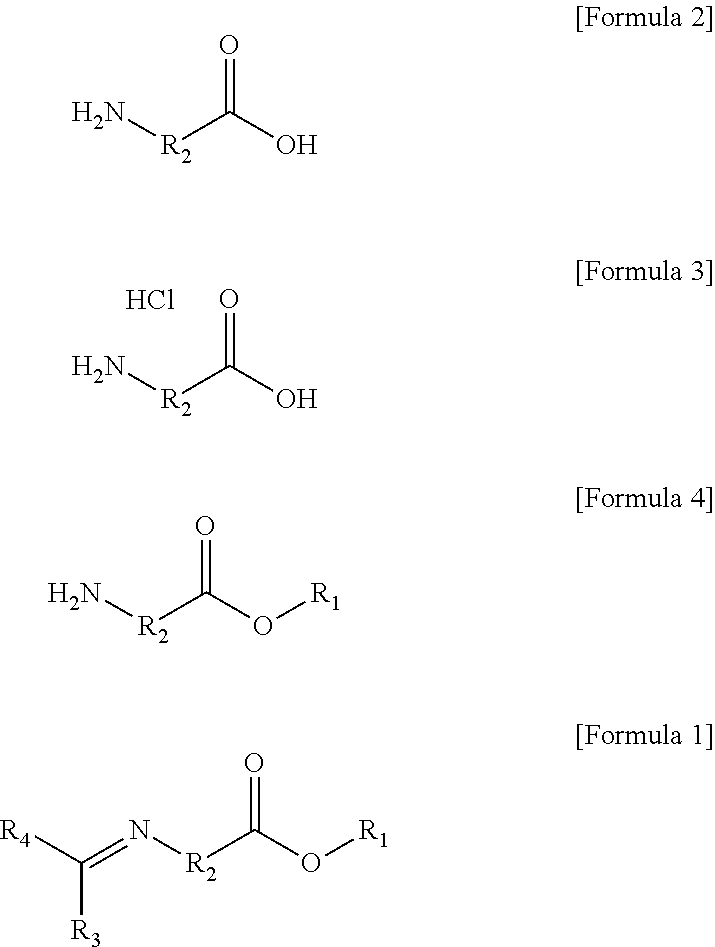Modified Conjugated Diene-Based Polymer And Method Of Preparing The Same
a conjugated diene-based polymer and modified technology, applied in the preparation of amino-carboxyl compounds, chemistry apparatus and processes, organic chemistry, etc., can solve the problems of reducing physical properties, br or sbr with the filler, reducing the abrasion resistance, crack resistance, or processability, etc., to achieve excellent affinity, high anionic reactivity, easy to react with an active si
- Summary
- Abstract
- Description
- Claims
- Application Information
AI Technical Summary
Benefits of technology
Problems solved by technology
Method used
Image
Examples
preparation example 1
er Represented by Formula 1-1
[0177]1) Preparation of Ethyl 6-Aminohexanoate Hydrochloride
[0178]After 240.0 g (1.83 mol) of 6-aminohexanoic acid was put in a 2 L round-bottom flask and 80 ml of ethanol was added thereto, the temperature was set at 0° C. Thereafter, a reaction was performed while 126.77 ml (1.74 mol) of thionyl chloride was slowly added for 30 minutes. When the exothermic process ended, a reaction was performed at room temperature for 12 hours or more, the reaction was then terminated, and the solvent was removed under reduced pressure. After 1 L of n-hexane was put and stirred for 30 minutes, the solution was filtered. After 1 L of diethyl ether was put, secondary stirring was performed, and the solution thus obtained was filtered and then concentrated to obtain 347.4 g (yield: 97%) of ethyl 6-aminohexanoate hydrochloride. 1H nuclear magnetic resonance spectroscopic data of the ethyl 6-aminohexanoate hydrochloride are as follows.
[0179]1H-NMR (500 MHz, CDCl3) δ 8.30 (...
preparation example 2
er Represented by Formula 1-2
[0186]1) Preparation of Ethyl 11-Aminoundecanoate Hydrochloride
[0187]After 30.0 g (149.02 mmol) of 11-aminoundecanoic acid was put in a 250 mL round-bottom flask and 100 ml of ethanol was added thereto, the temperature was set at 0° C. Thereafter, a reaction was performed while 10.33 ml (141.57 mmol) of thionyl chloride was slowly added for 30 minutes. When the exothermic process ended, a reaction was performed at room temperature for 12 hours or more, the reaction was then terminated, and the solvent was removed under reduced pressure. After 500 mL of n-hexane was put and stirred for 30 minutes, the solution was filtered. After 500 mL of diethyl ether was put, secondary stirring was performed, and the solution thus obtained was filtered and then concentrated to obtain 38.4 g (yield: 97%) of ethyl 11-aminoundecanoate hydrochloride. 1H nuclear magnetic resonance spectroscopic data of the ethyl 11-aminoundecanoate hydrochloride are as follows.
[0188]1H-NMR ...
preparation example 3
er Represented by Formula 1-3
[0195]1) Preparation of Ethyl 4-Aminobutanoate Hydrochloride
[0196]After 200.0 g (1.94 mol) of 4-aminobutanoic acid was put in a 2 L round-bottom flask and 500 ml of ethanol was added thereto, the temperature was set at 0° C. Thereafter, a reaction was performed while 134.38 ml (1.84 mol) of thionyl chloride was slowly added for 30 minutes. When the exothermic process ended, a reaction was performed at room temperature for 12 hours or more, the reaction was then terminated, and the solvent was removed under reduced pressure. After 1 L of n-hexane was put and stirred for 30 minutes, the solution was filtered. After 1 L of diethyl ether was put, secondary stirring was performed, and the solution thus obtained was filtered and then concentrated to obtain 315.7 g (yield: 97%) of ethyl 4-aminobutanoate hydrochloride. 1H nuclear magnetic resonance spectroscopic data of the ethyl 4-aminobutanoate hydrochloride are as follows.
[0197]1H-NMR (500 MHz, CDCl3) δ 8.27 ...
PUM
| Property | Measurement | Unit |
|---|---|---|
| temperature | aaaaa | aaaaa |
| temperature | aaaaa | aaaaa |
| molecular weight distribution | aaaaa | aaaaa |
Abstract
Description
Claims
Application Information
 Login to View More
Login to View More - R&D
- Intellectual Property
- Life Sciences
- Materials
- Tech Scout
- Unparalleled Data Quality
- Higher Quality Content
- 60% Fewer Hallucinations
Browse by: Latest US Patents, China's latest patents, Technical Efficacy Thesaurus, Application Domain, Technology Topic, Popular Technical Reports.
© 2025 PatSnap. All rights reserved.Legal|Privacy policy|Modern Slavery Act Transparency Statement|Sitemap|About US| Contact US: help@patsnap.com



